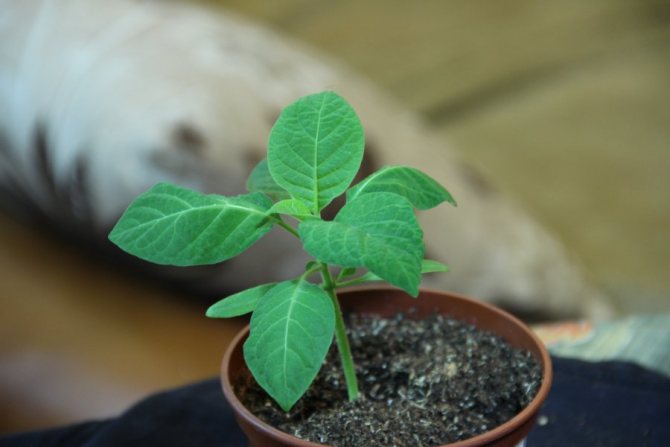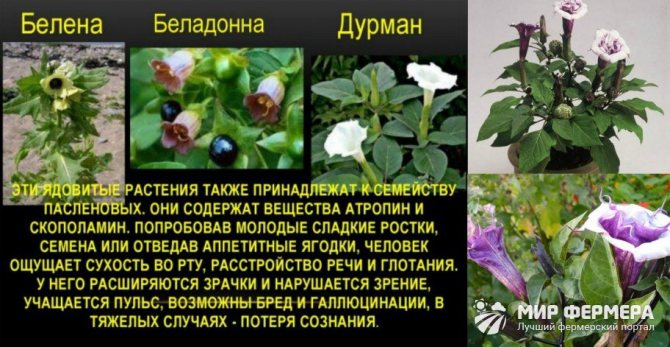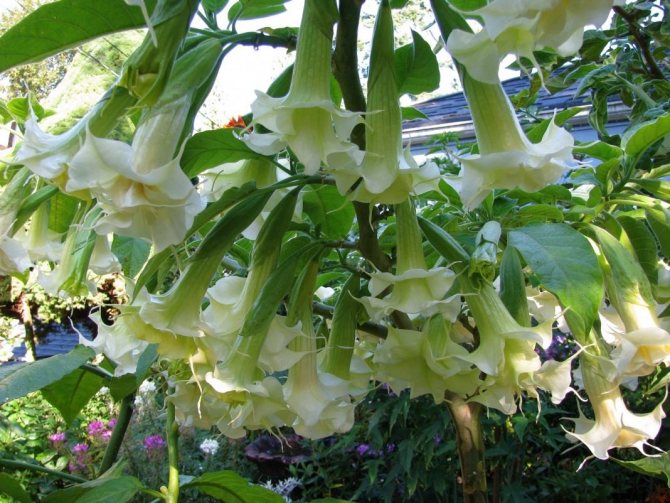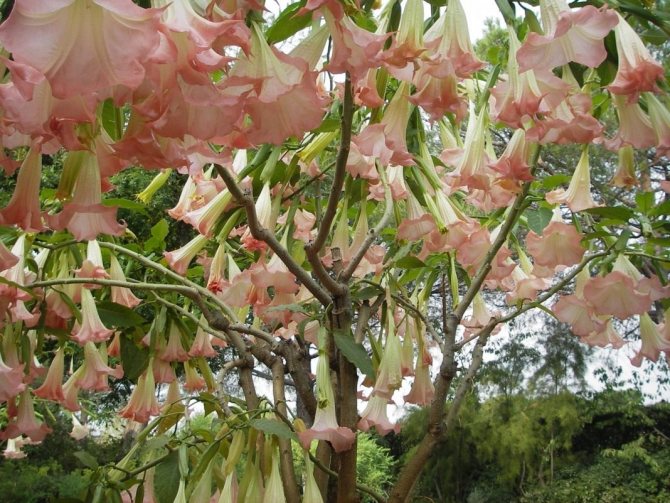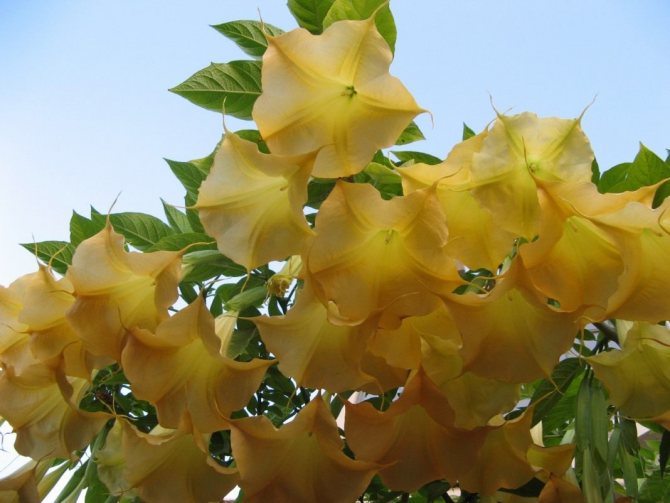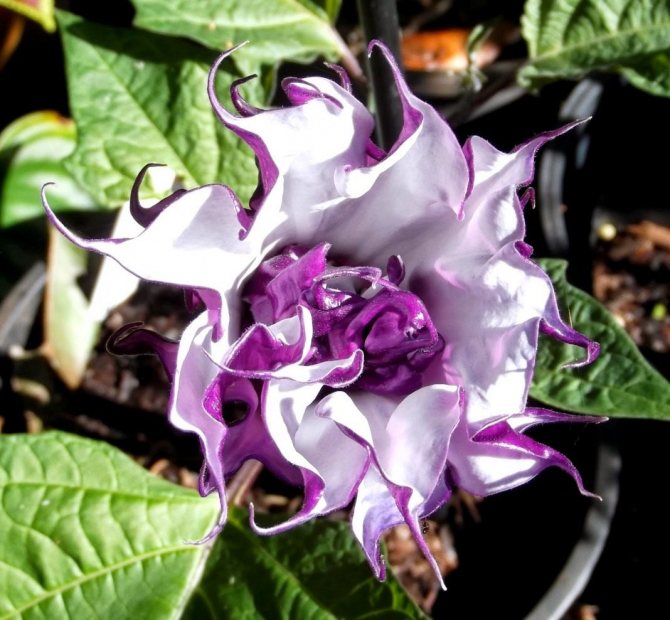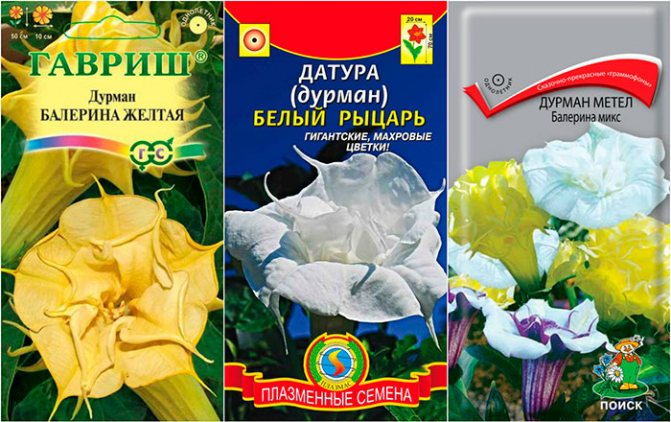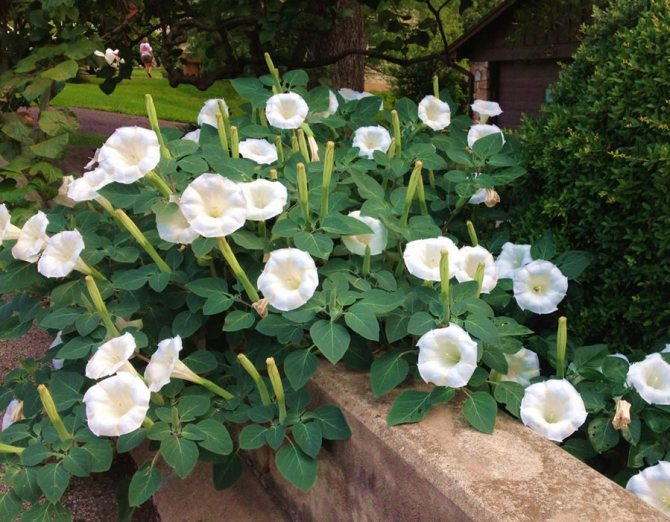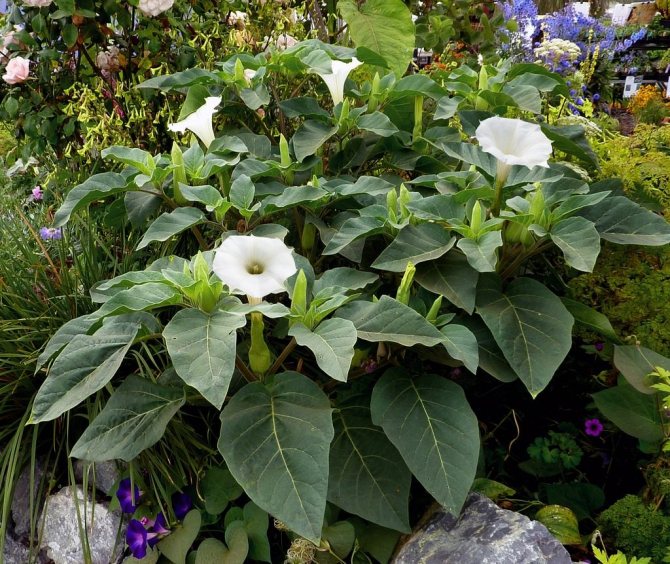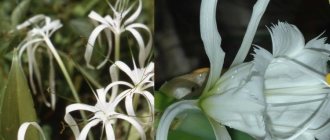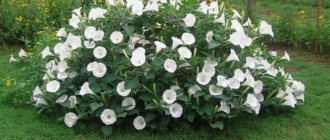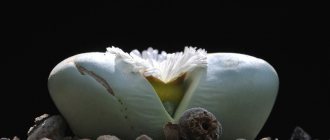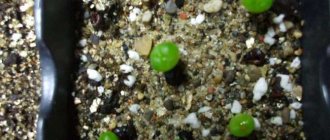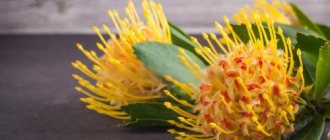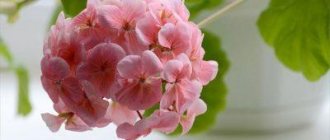Datura is the Latin name for common dope. Plant of the Solanaceae family, tall, distinguished by large velvety leaves and large fragrant flowers (up to 25 cm). People call it mad potion, water drunk, witch herb, dope herb. In fact, there is nothing dangerous in growing it, unless, of course, you use it for food. Loves loose soil rich in nitrogen, feels great on compost or dung heap, prefers warm climatic conditions.
Growing from seeds at home
Date easy to grow from seed... Planting material can be collected by yourself or purchased in specialized stores. In February or early March, you can sow seeds for seedlings in the house.
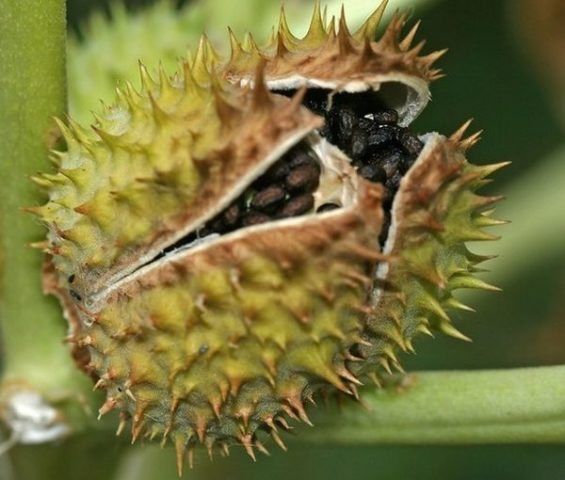
Seeds can be harvested by yourself or bought ready-made
For better germination, it is better to pre-soak them. Planting depth should not exceed 0.5 cm.
Be sure to take cups or boxes for planting, which have a great depth: the roots of the seedlings will grow quickly. A thin layer of peat is placed on the bottom. The soil must be chosen fertile and light, add river sand to it and steam well.
Datura seeds (Datura) very tenacious... Subject to the storage conditions, they will not lose the quality of germination within 10 years. In order to make sure that the planting material has not deteriorated, it is filled with hot water.
Seeds that can be used will remain at the bottom, and those that come up - a marriage. The percentage of germination and germination is amazing. 95% of seeds germinate. Germination times can vary from 10 to 50 days.
Step-by-step instructions for growing from seeds
The following actions will help to maximize the percentage of seed germination:
| Growth stimulants | Before planting, the seeds should be soaked in a solution of epin or zircon |
| Greenhouse effect | Moisturize the earth Plant seeds Irrigate with warm water Covered with foil or glass, creating a greenhouse |


Growth stimulant helps accelerate seed germination
After the seeds have fallen into the ground, you need to:
- Maintain the air temperature at about 25˚С, as soon as the first shoots appear - 18-20˚С.
- Young sprouts will need a lot of light to keep them from stretching out.
- "Kids" Datura follows treat with any fungicideas soon as they are born. This will exclude the possibility of being affected by the "black leg" disease, which is highly susceptible to seedlings.
The grown sprouts are transplanted into a pot, when the first leaves appear, they dive. Water regularly 3 times a week. When the threat of frost has passed, Datura is relocated to street conditions for permanent residence.
It is growing rapidly. Already in June, it may begin to bloom, which will last until September.
Sowing seedlings
To achieve early flowering, seeds are planted throughout March to obtain seedlings. To do this, use cassettes or cups. Terry Datura seeds are large enough and can be stored for a very long time. That is why the preliminary preparation and sorting of seeds is very important.
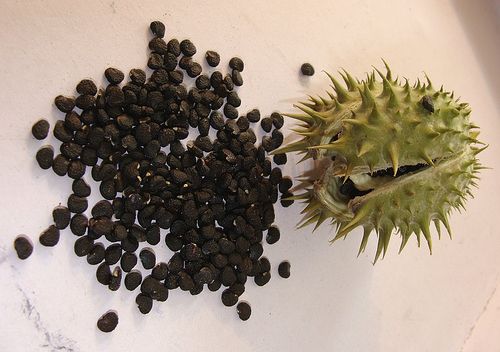

For this, soaking is used in two stages. The first for rejecting light seeds that float to the surface when immersed in water. When sowing, they will not sprout, and therefore they are simply thrown away.The second stage is soaking in a humid environment (for example, in aloe juice) for two days to improve germination.
It is better to sow the date directly in separate cups, so that later on not to carry out a pick and to save time. In this case, it is necessary to select tall cups or cassettes, since this flower has a deep root system.
For seedlings, you can use regular soil mixtures for garden flowers or for succulents. The containers are filled with soil by about two-thirds and are well moistened. Then a layer of dry soil is poured and buried in it (no more than a centimeter) one by one seed of terry datura. The topsoil is lightly sprayed with water and then the crops are covered with foil to obtain a small greenhouse effect. For active germination, an ambient temperature of twenty degrees Celsius is provided.
Video. Datura pick
The first shoots of datura appear within fifteen days, during which it is necessary to ventilate the mini-greenhouse, and also irrigate with a spray. After complete germination, the film is removed completely. If cloudy weather prevails for a long time during the growth of seedlings, it is necessary to organize supplementary lighting with special phytolamps.
Flower facts
Description
Datura has wide habitat... "Devil Grass" is native to Asia. She feels great in the Crimea, in the south of Russia, in the Caucasus, in Ukraine and in the West of Siberia.
Wild Datura grows near houses, on wastelands, near ravines. The flower loves loose, moist and nutritious soil. Usually grows in clusters.
Any gardener can handle Datura grass on a garden plot. The flower is not whimsical at all to watering and care, it practically grows by itself. In the middle lane, its seeds rarely ripen, and it is considered a one-year-old.
In the southern regions of Datura self-sowing from year to year and can occupy large areas, sometimes it is equated with a weed.
Datura is an annual light-loving plant, reaching a height of more than 1 m. It grows in the form of a bush. It has large and very beautiful bell-shaped or funnel-shaped flowers.
Flowers can be of various shades, but most often white. Unfortunately, Datura flowers fade quickly. This is compensated by the fact that there are a lot of flowers on one bush and they bloom quickly.
Datura - night plant, in the evening the buds bloom and exude a sweet aroma, which is not recommended to enjoy for a long time.
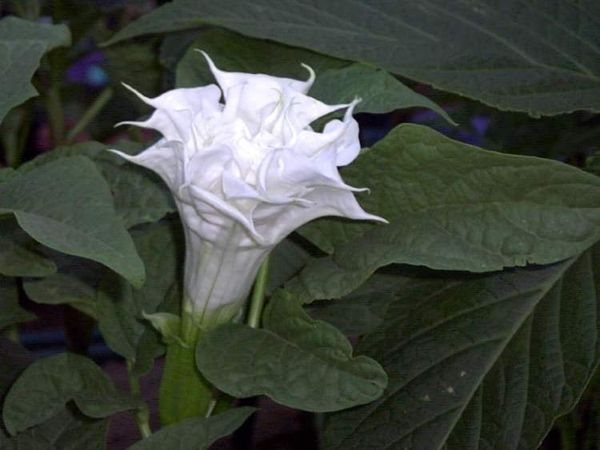

To breathe the scent of datura for a long time is strictly contraindicated.
With the arrival of the sun's rays, the flowers close. An ornamental variety will give any garden an exotic flavor with its own history:
| In ancient times | nicknamed "mad potion" was used to poison victims and traitors |
| Today | all parts of this plant are poisonous Its use can cause hallucinations and even drug intoxication. |
That is why, for those who have small children and curious animals in their home, it is better to refrain from growing it in their garden.
If you are concerned about the topic of dangerous plants, then an interesting article on the 10 most poisonous indoor plants will be.
Datura flower - houseplant
Few people know that the plant can be grown at home... With the onset of autumn, it can be dug up in the garden and planted in a voluminous tub. Thus, Datura will grow in the house for many years.
Such a beauty will need a large and bright room. In the summer, you need to take it out into the fresh air in the garden or on the balcony. With the onset of the autumn cold, they are brought into the house.
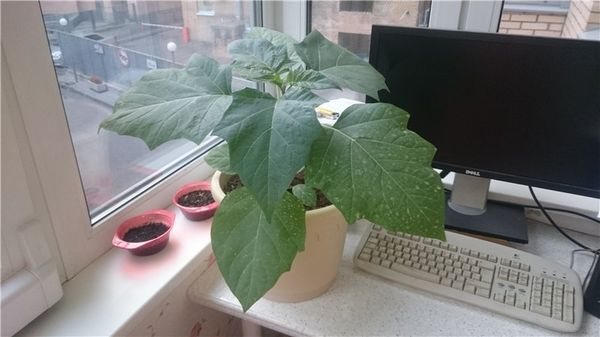

In the cold season, the plant is removed indoors.
In winter, he needs regular watering and being away from radiators.
At a young age, feeding not required until first flowering... Then mineral and organic fertilizers are alternated every week. In winter, they give the plant a break.
To have Datura in the house means to be a great original. When you find a dope flower in the house, do not forget about its poisonous qualities.
Plant care
Purslane growing from seeds - when to plant
Datura is rather unpretentious in cultivation. The main care for full growth is high-quality soil, regular watering and pruning.
Watering
The plant has large leaves that evaporate a lot of moisture, especially during the period of active growth, then it needs the most abundant irrigation. Watering should be done often, at least every other day, and on hot days - even every day. With a lack of moisture, Datura will begin to shed foliage, buds.
When growing datura as a houseplant, watering in winter is reduced to once a week.
Pruning
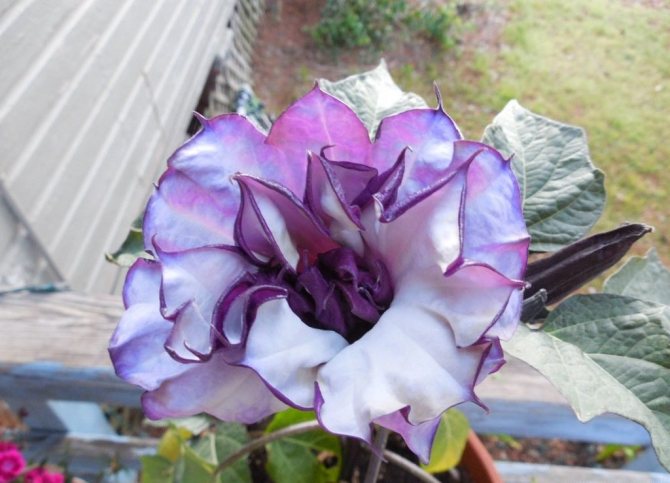

Datura has different shades
Pruning is a prerequisite for the full growth of Datura. Flowers on this plant are formed only on young shoots, therefore, branches are cut every autumn, thereby forming a crown. In addition, the plant requires regular removal of faded heads - this activates the flowering process.
Top dressing
In the summer season, the plant is fed every week using mineral and organic fertilizers (alternating).
In addition, it is necessary to take into account that prolonged growth contributes to a significant growth of the bushes, a close group planting will disrupt the correct flowering process, the plants will simply interfere with each other, the use of single plantings is optimal.
Wintering
Indoor plant
Houseplants require high-quality lighting, allow through the sun's rays. For the winter season, the plant is moved to a room with a cool temperature (10-12 ° C), where the flower falls into a dormant period, shedding foliage. A temperature of more than 16 degrees provokes the stretching of the shoots and the weakening of the plant.
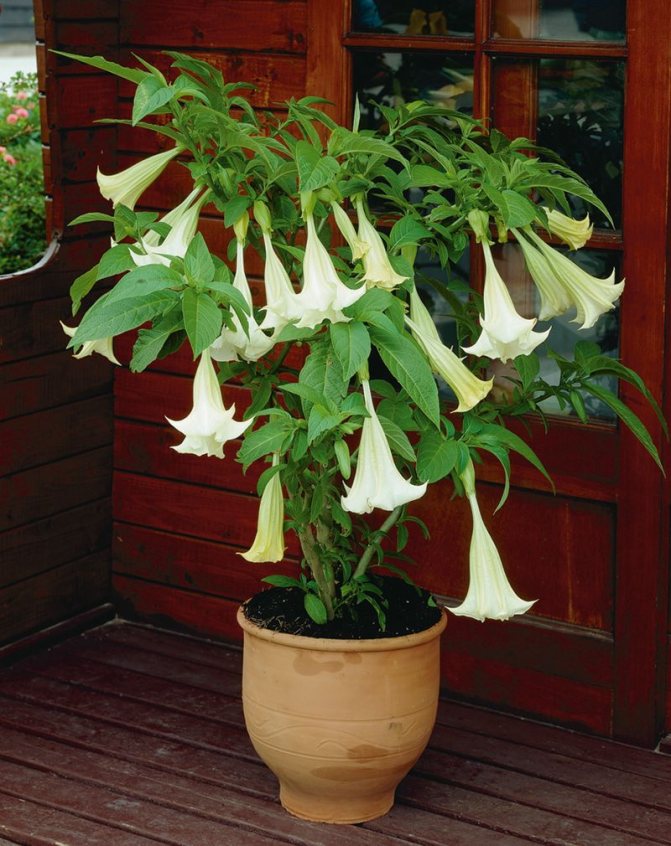

Indoor plant
The overwintered plant is transplanted into fresh soil at the end of winter or in the first spring days. The soil is prepared from clay-sod, greenhouse soil and sand (4: 2: 1) or from equal parts of humus, peat and sand. It is important to provide the plant with drainage and a drainage hole. In larger plants, the top of the soil is changed.
Streetwear
In the open field, the plant dies almost instantly from any frost. Therefore, in order to preserve the dope, it is necessary to transplant it into a suitable pot and place it in a warm place (house, balcony, veranda). After wintering, the plant is weakened, less viable and blooms worse, therefore Datura is most often grown as an annual crop.
"The devil is not so terrible as he is painted" - in a sense, this statement applies to Datura. Despite such "bad" fame, he is not so bad, the main thing is to use him correctly. In addition, none of the plants have such beautiful flowers anymore - they are an excellent option for decorating a garden or home.
Reproduction
Datura can be propagated by seed or cuttings. In natural wild and natural conditions, this flower propagated by seeds.
Seed reproduction
For home seed propagation, you will need to collect the seeds yourself from the ripe fruit "pods" (or buy seeds in the store). Outwardly, the "boxes" look like a prickly egg.
Inside which there are more than 500 seeds are usually black. Then germinate seeds and dive young plants, as described above.
Cutting method
Propagate Datura you can also cuttingswho have not yet had time to stiffen. In the summer, they are rooted in nutritious humus and cut off. Cuttings overwinter in the warmth, and as soon as the frost ends, they can be planted in street soil.
Landing features
Datura is known to be ideal for growing a dung or compost heap. Under favorable conditions, the plant is capable of self-seeding.In some cases, seed germination is observed even in autumn, and the first seedlings are able to tolerate cold weather. The seeds remaining in the soil germinate in early spring. It is worth noting that experts recommend sowing dope in the period from April to May.
The plant is considered unpretentious. He needs a sufficient amount of nutrients and moisture, as well as loose soil to which ash should be added.
Particular attention should be paid to the preparation of the planting holes. They should be about 70 cm deep and 50 cm in diameter. drainage must be used
... If the dope is buried too deeply during planting, it may not survive.
Some gardeners prefer to plant the plants in containers. In this case, a fairly large capacity is required. Flower pots can be dug into the ground in summer if desired. An illuminated area without drafts is ideal for dope.
The soil mixture for the seeds must be prepared in advance. This can be done even in the fall. So, you will need garden land, coarse river sand and humus in a ratio of 2: 1: 2.
Some gardeners to speed up germination check seeds for germination
... So, they are placed in a container of water. The floating seeds are thrown away, and the rest are used for planting. Planting seeds for seedlings must be done in March. It should be remembered that the seeds germinate from a depth of up to 10 cm. If planting in open ground is planned, then the beginning of May is best suited.
Datura seedlings appear on average after 2-4 weeks. Even before they appear, it is necessary to ensure that the soil is constantly wet. To do this, you can additionally cover the area with foil. As soon as the first shoots appear, the seedlings must be transferred to a lighted cool place. Formation of a pair of true leaves indicates the need for a pick
... All seedlings are planted in separate containers. In this case, they need to be slightly deepened. When planting in open ground, which is carried out at the end of May, you need to ensure that there is a gap of 1 m between individual plants. This is very important, because the plant loves space.
Some experts prefer to propagate Datura by cuttings. For this, still unlignified shoots with a pair of internodes are cut from the plant. They take root in soil or water. Already rooted plants are planted in open ground in May. If you plan to grow dope at home, then you can cut the cuttings at any time of the year.
Winter content
If Datura is left on the street in the middle lane with cold winters, then he will die. If desired, adult plants can overwinter indoors, but already in a cool one. Gardeners dig Datura in the fall and transplant it into a tub, cutting off excess stems.
During wintering, the flower undergoes preventive cuts, it often does not need to be moistened.
This way plant conservation enjoys little demand - the flower loses its vitality compared to those propagated by cuttings or grown from seeds. As a result, Datura herb is grown as an annual plant.
Breeding on the site
Datura looks very attractive during the flowering period. Certain varieties of Datura are planted by gardeners in garden plots for decorative purposes, especially since the plant is unpretentious in care. And flowering is accompanied by the spread of a pleasant aroma with tropical notes, overlapping other smells in the garden.
For full growth and abundant flowering, a flower needs a lot of sunlight, regular watering and loose soil. In the shade, the plant grows poorly and looks unattractive. The need for moisture is due to increased evaporation through large sheet plates. From a lack of water, the flower leaves and buds fall off. The soil should be nutritious, rich in organic matter.Acidic soils are not suitable for growing.
Plant on the site
During the season, feeding is carried out every week, alternating between the mineral composition and organic matter. Flowering is stimulated by hard water such as milk of lime. Unopened tubules of flowers indicate a lack of nutrition and moisture.
The bushes are transplanted into pots for the winter and placed in a non-residential, bright room with a temperature of no higher than + 15 °, otherwise the plant will stretch out. Watering is rare. After wintering, when some of the leaves fall off, pruning is done.
A feature of the plant is its "monopoly" on space. Weeds do not grow near it. Datura's poisonous properties keep them at a distance, just like parasitic insects.
How to plant in open ground
Datura grown in the open field will noticeably differ from the indoor one in its chic forms. Datature in pots is always small, its inflorescences are formed unevenly.
The difference can be clearly seen if you transplant Datura from a pot into open ground.
In just a couple of months "devil's flower" will turn into a massive shrub a meter high and covered with an incredible number of inflorescences. Its intoxicating scent will be felt in every corner of the garden.
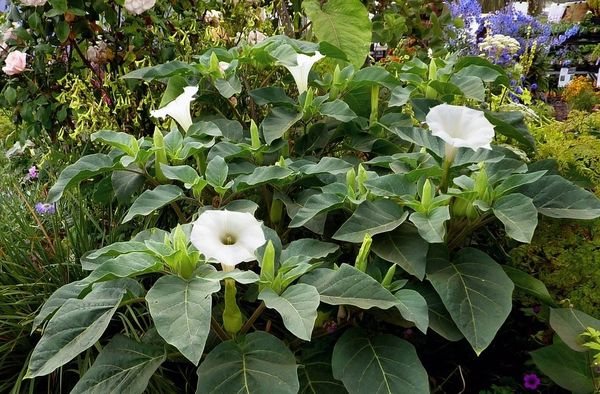

The pet can grow to a large bush
It is for these reasons that the popularity of open field cultivation exceeds the potting method.
Terry datature: flower photo
Datura is a beautiful plant that is mistaken for a weed in most countries. In our country, it is customary to grow this flower for landscaping summer cottages and city flower beds. Datura flowers have a delicate white color with various shades and thin the pleasant intoxicating scent. Datura is considered a poisonous plant, so it is not recommended to grow it for people who have small children and animals.
Our grandmothers, growing garden strawberries, or strawberries, as we used to call them, were not particularly worried about mulching. But today this agricultural practice has become fundamental in achieving high quality berries and reducing crop losses. Someone might say that it is troublesome. But practice shows that labor costs in this case are repaid a hundredfold. In this article, we invite you to get acquainted with the nine best materials for mulching garden strawberries.
Succulents are very diverse. Despite the fact that “babies” have always been considered more fashionable, the assortment of succulents that can be used to decorate a modern interior is worth taking a closer look at. After all, colors, sizes, patterning, degree of prickle, influence on the interior are just a few of the parameters by which you can choose them. In this article, we will tell you about the five most fashionable succulents that amazingly transform modern interiors.
Mint was used by the Egyptians as early as 1.5 thousand years BC. It has a strong aroma due to the high content of various essential oils with high volatility. Today mint is used in medicine, perfumery, cosmetology, winemaking, cooking, ornamental gardening, and the confectionery industry. In this article, we will consider the most interesting varieties of mint, and also talk about the features of growing this plant in the open field.
People began to grow crocuses as early as 500 years before the advent of our era. Although the presence of these flowers in the garden is fleeting, we always look forward to the return of the heralds of spring next year. Crocuses are one of the earliest primroses that bloom as soon as the snow melts. However, the timing of flowering may vary depending on the species and varieties. This article focuses on the earliest crocus varieties that bloom in late March and early April.
Cabbage soup from early young cabbage on beef broth - hearty, aromatic and easy to prepare. In this recipe, you will learn how to cook a delicious beef broth and cook light cabbage soup in this broth.Early cabbage cooks quickly, so it is put into the pot at the same time as the rest of the vegetables, unlike fall cabbage, which takes a little longer to cook. Ready-made cabbage soup can be stored in the refrigerator for several days. The present cabbage soup turns out to be tastier than the freshly cooked one.
Blueberry is an uncommon promising berry crop in orchards. Blueberries are a source of biologically active substances and vitamins, they have antiscorbutic, anti-inflammatory, antipyretic, restorative properties. Berries contain vitamins C, E, A, flavonoids, anthocyanins, trace elements - zinc, selenium, copper, manganese, as well as plant hormones - phytoestrogens. Blueberry berries taste like a mixture of grapes and blueberries.
Looking at the variety of tomato varieties, it is difficult not to get confused - the choice is very wide today. Even experienced gardeners are sometimes confused by it! However, it is not so difficult to understand the basics of selecting varieties "for yourself". The main thing is to delve into the peculiarities of culture and start experimenting. One of the easiest tomato groups to grow are varieties and hybrids with limited growth. They have always been appreciated by those gardeners who do not have a lot of energy and time to care for the beds.
Once very popular under the name of indoor nettles, and then forgotten by everyone, coleus today are one of the brightest garden and indoor plants. They are not in vain considered stars of the first magnitude for those who are looking primarily for non-standard colors. Easy to grow, but not so undemanding to suit everyone, Coleus require constant monitoring. But if you take care of them, the bushes of velvety unique leaves will easily outshine any competitor.
Salmon ridge baked in Provencal herbs is a "supplier" of tasty pieces of fish pulp for a light salad with fresh leaves of wild garlic. Champignons are lightly fried in olive oil and then poured with apple cider vinegar. These mushrooms are tastier than regular pickled mushrooms and are better for baked fish. Ramson and fresh dill get along well in one salad, emphasizing the aroma of each other. The garlic pungency of wild garlic will saturate both the flesh of the salmon and the pieces of mushrooms.
A coniferous tree or shrub on the site is always great, and many conifers are even better. Emerald needles of various shades adorn the garden at any time of the year, and phytoncides and essential oils secreted by plants not only flavor, but also make the air cleaner. As a rule, most of the zoned adult conifers are considered to be very unpretentious trees and shrubs. But young seedlings are much more capricious and require competent care and attention.
Sakura is most often associated with Japan and its culture. Picnics under the shade of flowering trees have long become an integral part of the welcome of spring in the Land of the Rising Sun. The financial and academic year starts here on April 1, when the magnificent cherry blossoms are in full bloom. Therefore, many significant moments in the life of the Japanese pass under the sign of their flowering. But sakura grows well in cooler regions - certain species can be successfully grown even in Siberia.
I am very interested in analyzing how the tastes and addictions of people to certain foods have changed over the centuries. What was once considered tasty and was an object of trade lost its value over time and, conversely, new fruit crops conquered their markets. Quince has been cultivated for over 4 thousand years! And even in the 1st century BC. e. about 6 varieties of quince were known, and even then methods of its reproduction and cultivation were described.
Delight your family and make themed Easter egg-shaped cottage cheese cookies! Your kids will be happy to take part in the process - they will sift the flour, combine all the necessary ingredients, knead the dough and cut out intricate figures.Then they will watch with admiration how the pieces of dough turn into real Easter eggs, and then they will eat them with the same enthusiasm with milk or tea. How to make such an original cookie for Easter, read our step-by-step recipe!
There are not so many decorative leafy pets among tuberous crops. And Caladium is a true star among the variegated inhabitants of interiors. Not everyone can decide to start a Caladium. This plant is demanding, and first of all - to care. But still, rumors about the extraordinary capriciousness of the Caladiums never justify. Care and attention will avoid any difficulty in growing caladiums. And a plant can almost always forgive small mistakes.
We have prepared a hearty, incredibly appetizing and simply elementary dish for you today. This gravy is one hundred percent universal, as it goes with every side dish: vegetables, pasta, or whatever. Gravy with chicken and mushrooms will save you in moments when there is no time or you don't want to think too much about what to cook. Grab your favorite side dish (you can do this ahead of time to keep everything hot), add the gravy and lunch is ready! A real lifesaver.
In the family Solanovykh
there is a plant about which hundreds of legends have been written.
it Datura
(Datura) - healing and poisonous, it bewitches with intoxicating, delicate aroma and splendor of large, open to the sky, tubular flowers.
At home
, in Central America - a large, loose perennial bush up to 1.5 meters in height often grows everywhere like a weed, and does not differ in particular decorativeness.
On the territory of the former CIS, it has been called for a long time dope
.
Outdoor cultivation
You can grow Datura grass for open ground by seedlings or sowing. Germinating seeds of Datura grass for planting in open ground is fundamentally no different from the method that is applied to potted plants.
Datura seedlings
Datura seedlings should be planted as follows:
- They are planted only when the air temperature will no longer drop. below the 3 ° C mark... This time falls at the end of May - beginning of June.
- The place is chosen protected from the winds so that the plant can grow full-fledged.
- The soil should be loose and fertile.
- Complex mineral fertilizers are applied immediately. In the future, this is required to be done once a week. Top dressing increase flowering duration.
Before applying top dressing, it is necessary to moisten the soil. During extreme heat, it is better to stop using various drugs. This can lead to the death of the plant.
- Placing the sprout in the ground, it is watered with rainwater and sprinkled with earth on top. This will prevent rapid evaporation of moisture.
- The distance between the "Daturyats" should be at least 1 meter... Growing, the plant requires a lot of space.
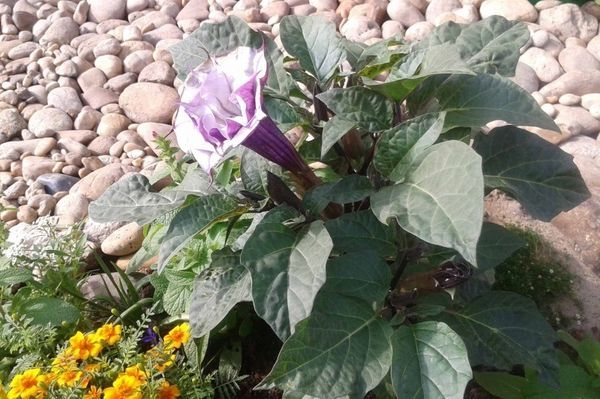

Growing datura grass from seedlings allows you to get seedlings faster than seed growing
Datura seeds
Datura can be sown directly into open ground. This method will appeal to those who are not friends with seedlings. It should only be taken into account that the seeds can germinate if the planting depth does not exceed 10 cm, and the night temperature does not drop below 15-20 ° C.
Top dressing does not need to be applied immediately, but be sure to water once every 3 days.
Pick and transfer
When 1-3 true leaves appear at the shoots of Datura, they must be dived into separate containers at least 7 cm in diameter. When transplanting, you need to deepen the stem to the cotyledons. It will be necessary to transplant terry datura when grown from seeds when the container is filled with its roots. Therefore, it is better to take transparent containers for seedlings.
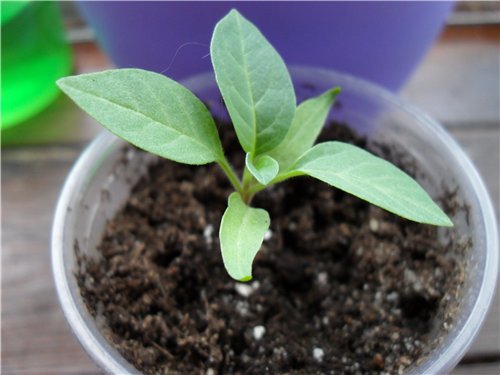

At the next transshipment, the plants must be carefully removed from the pot without destroying the earthen lump.In a container where datura will grow continuously, a drainage layer about 10 cm thick should be provided. It can be made from large pebbles or rubble, fragments of brick or glass, ceramics and other similar materials.
A layer of fertile soil should be poured over the drainage. The surface of the earthen clod at the bush, set on the soil, should be about 5 cm below the edge of the pot. Cover the gap between the container wall and the earthen clod with the substrate, as well as part of the stem. The level of the new soil in the container should be 1.5-2 cm below its edge. In a similar way, indoor datura will need to be replanted as the soil is filled with roots. Moreover, each time the container should have a larger diameter (by 8-10 cm).
If the dope grows in a street flowerpot or open ground, then the transplant is made only at the moment the seedlings are taken out of the house. Plant care consists in timely watering.
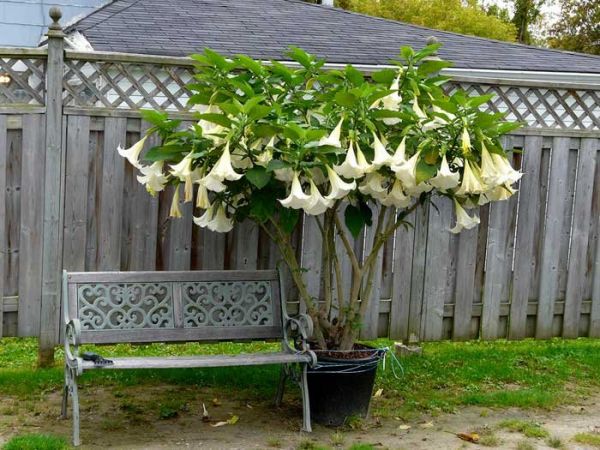

Types and varieties of Datura
Several types of the devil's flower are popular among gardeners. They can often be seen in summer cottages and household plots:
Common (Datura stramonium)
A plant with huge white flowers, shaped like bells. The spherical fruits have sharp thorns. The leaves are large, gray-green. In southern countries considered a weed.
Native American (Datura Innoxia)
It differs from the ordinary one in the specific color of the leaves: gray-green, closer to gray-blue. The flowers are white.
Used by Indians in occult rituals to evoke various visions.
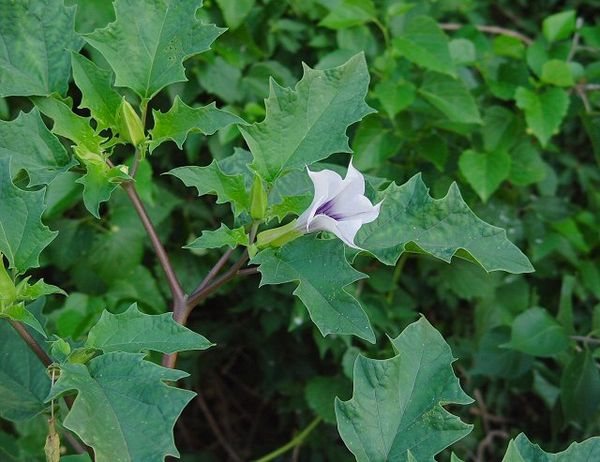

Datura stramonium
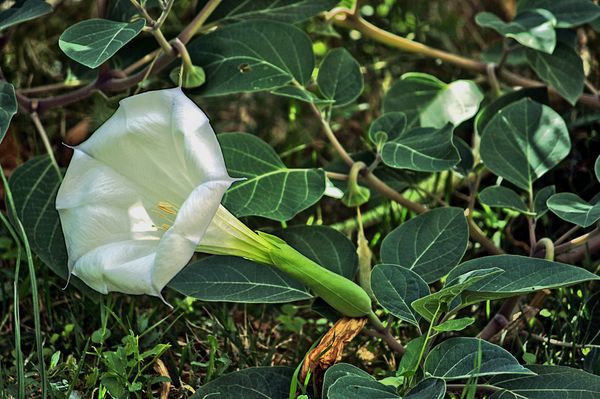

Datura Innoxia
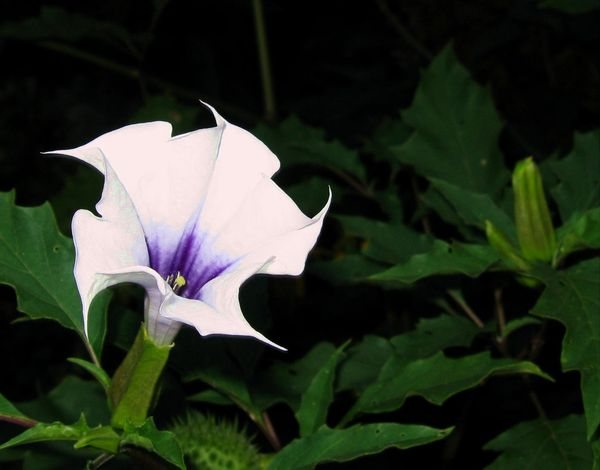

Datura metel
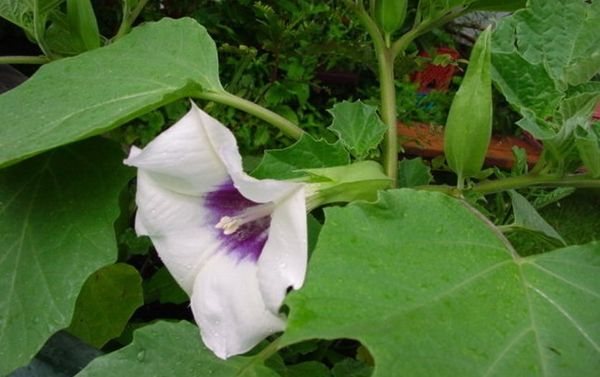

Datura stramonium Tatula
Indian (Datura metel)
"Flower of Shiva" revered in India, has a divine origin. Its flowers, with a delicate and white-purple veil, envelop the bush, creating a unique sight.
Purple (Datura stramonium var. Tatula)
Gained its popularity for its unusual bluish-lilac color of the flower.
Terry
Datura looks great too with double flowers... There are several types and colors of them. Datura terry white, orange, red, purple and others.
Note that not only Datura has the Makhrovy variety. For example, this is one of the varieties of chubushnik shrub.
A distinctive feature of these species is considered to be a light delicate aroma. They are best suited for indoor cultivation.
An indisputable plus of Datura (Datura flower) is its diversity, which exceeds the expectations of the most demanding flower growers. Excluding him poisonous characteristics, cultivating a garden Datura is a very enjoyable experience.
Datura blooms for a long time and abundantly, does not require care, pests bypass it. Datura will be a great addition to landscape design. Undoubtedly, the maintenance of the witch's Datura at home is a purely personal matter.
Datura. Description
Datura (the Latin name for Datura) recently appeared in our gardens, but quickly won the hearts of flower growers. Its huge flowers have an amazing ability to transform the garden space, make it lighter and more spacious. The most beloved by gardeners is fragrant dope: an evergreen shrub up to 5 m tall. Datura shoots erect, branching. Leaves 15-25 cm long, 5-12 cm wide, alternate, petiolate, oblong-ovate or narrowly elliptical, pointed, entire. Datura flowers solitary, large (20-30 cm long), axillary, hanging, fragrant. Calyx 2 5 dentate, slightly swollen, preserved in fruit. Datura whisk spine-lobe, limb funnel-tubular or bell-shaped, white. Fetus - a two-celled elongated juicy berry.
Datura scented (pink, yellow), terry white, and also ordinary white grow most often in the garden. They do not give seeds (except for white) and, therefore, reproduce exclusively by vegetative means.
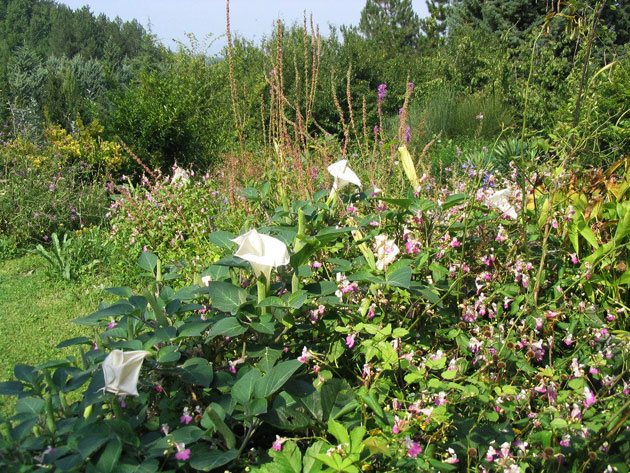

Germinate seeds faster! ↑
Planting and growing datura is very easy! There is a huge amount of seeds of all kinds on the market of planting material. Any self-respecting company will surely hide the cherished 3-4 seeds in a multi-colored bag.
The seeds are rather large, covered with a dense seed coat. Germination rate is very high - 95%, lasts up to 10 years.
One obstacle is that it usually takes a very long time to wait for the first shoots, sometimes up to 30 days.
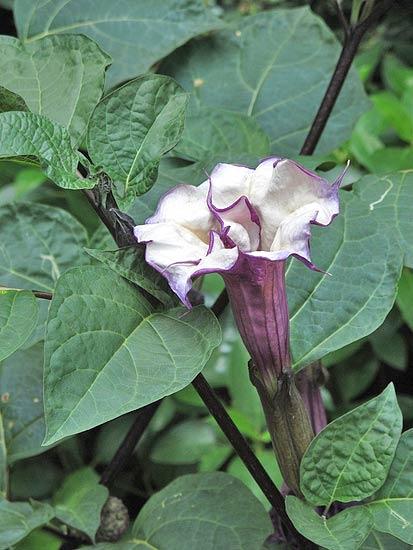

To rush the cute miracle of nature a little, you can soak the seeds in cool water or a growth stimulant solution for a couple of days. This will help loosen the tight bonds of the seed coat a little and give the light of new green life faster. Practitioners recommend using a zip pack with a little water. Place the seeds there and wait until they hatch, then boldly plant them in the ground and enjoy the shoots.
Diseases, pests
Datura is quite resistant to diseases and pests. Unfavorable conditions increase the likelihood of being damaged by pests: aphids, red spider mites. Threats are also posed by: forest bug, weevil, whitefly.
Of the diseases, the most common is gray rot.
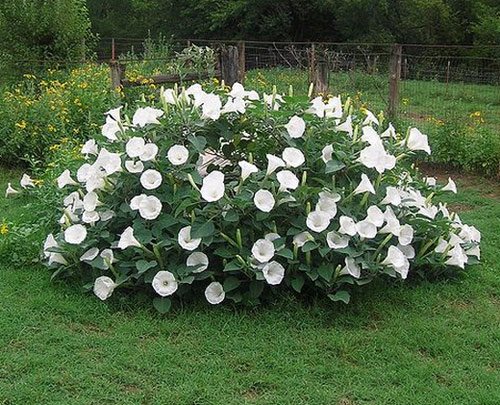

Datura is self-sufficient, against the background of the lawn
Growing tips and care ↑
The soil. It is better to choose the soil rich in organic matter. Datura grass loves loose nutritious soil, well-drained.
Place in the garden. There are several conditions required for a datura to develop properly. First, there is enough room to grow. Second, a sunny place or slightly shaded is ideal. In the shade, the flowering time will be shortened, and the plant will stretch out strongly. Last but not least, no strong winds! Otherwise, the plant will tilt to the sides, break, lose buds.
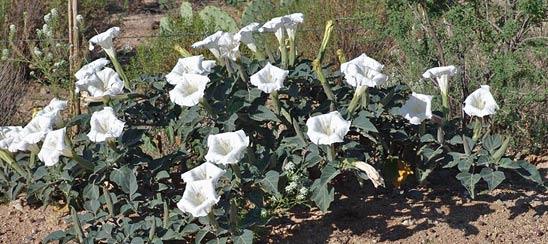

- A bush with beautiful large flowers looks great as a single plant in the green of the lawn.
- Perfectly complements group plantings and mixborders.
- The plant can be used to fill voids in a flower bed after perennials have faded.
- Datura Indian species is suitable for growing in a pot or container. However, in this case, it does not grow large.
Watering. Datura herb is very demanding on water quality. Soft water and regular watering will improve the flowering of this plant.
It grows actively in spring and summer, therefore, during this period, it requires additional fertilizing and abundant watering, spraying the foliage. With a lack of moisture and humidity, it drops buds and leaves.
Withered flowers must be removed so that the plant does not waste energy on the formation of fruits, but is completely devoted to flowering.
Fertilizers. It responds very gratefully to organic fertilizing (compost, dung, manure). Grows well on compost heaps. It is advisable to apply mineral fertilizer 2-3 times a month.
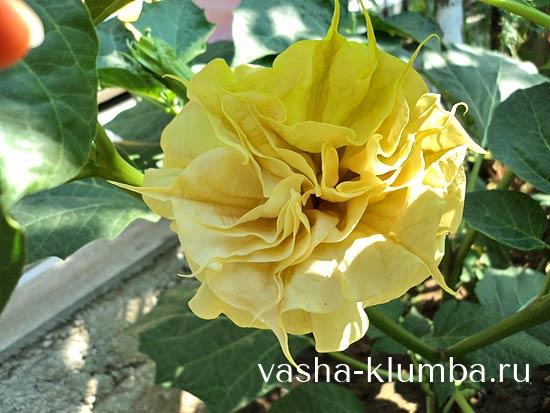

You can find out what types of datura can be grown with us and see their photos in our other article on the types of datura grass.
Use in landscape design
Datura can be grown in group, single plantings, effectively filling the background of mixborders. Branched bushes with noticeable flowers will adorn any flower garden, while filling the garden with aroma. Indian datura is good as a potted, container specimen.
Datura creeps along the ground rather than stretches in height. This sprawling plant can be used in plantings, covering empty spaces after the flowering of early flowering perennials, from which practically nothing remains in the middle of summer. To raise the "soaring" flowers of dope to eye level, you can build a support from several branches.
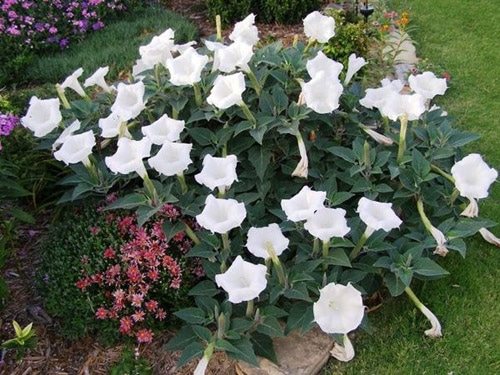

Datature in landscape
The Datura plant has taken root all over the world, not least due to its various pharmacological properties. Its psychotropic effect and anti-asthmatic effect are widely used. It is a natural drug, antidote, antidepressant, prophylactic against rabies, tetanus.
Photo gallery of views
Datature in landscape design: combinations with other plants, photos
A lush datura bush will perfectly decorate a green lawn or a lawn near the house. For long branching stems, trellis supports are erected, then the plants will seem even more voluminous. The free-flowing varietal datura will decorate the edges of the footpath or mixbrder. It can be supplemented with daylilies, cornflowers, St. John's wort, tulips.Potted Indian datura will fill the garden with their aroma, place them near the gazebos and recreation areas.
Attention! All parts of the datura are poisonous.
In flower arrangements, datura is planted in the center, decorated with flowering or ground cover crops. The datura looks good against the background of other shrubs: park rose, hydrangea, jasmine, lilac, forsythia. In groups, pay attention that the plants are combined in shape and color, as in the photo. It is successful when the plants are selected according to the flowering time, that is, life and color changes do not stop on the flower bed until autumn.
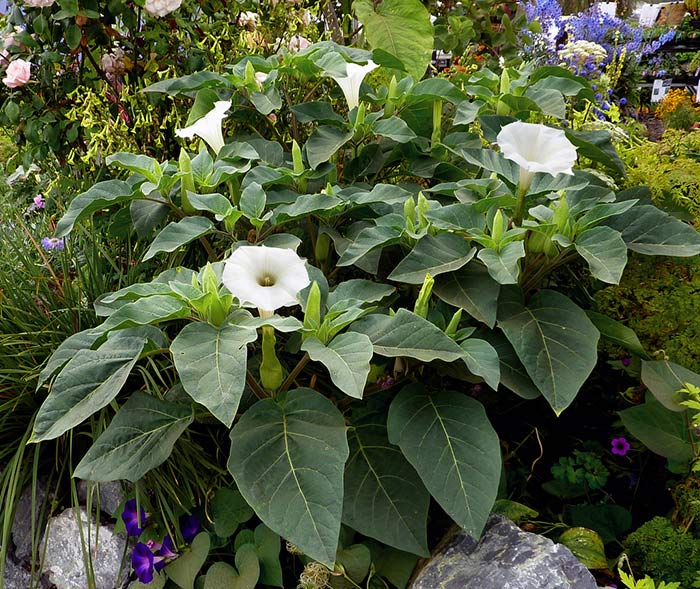

Datura in the garden
Many are afraid to breed datura on the site, due to its toxicity. Perhaps this is true only if you have small children. A growing crop is not dangerous, so take a look at these gramophone flowers and add the datura to your list of garden flowers.
Bloom reaction
Datura contains a poisonous substance called datarin. Accidental use of the component can raise blood pressure to a critical level, increase heart rate and block secretion. A small dose of poison will cause aggressive behavior.
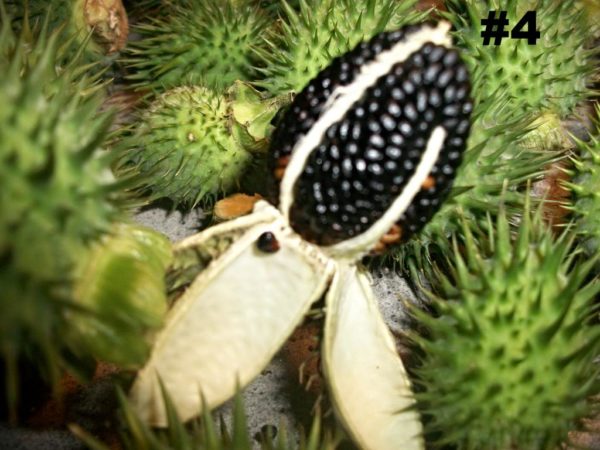

Eating berries or other parts of the datura can cause severe poisoning.
The main signs of the impact of culture:
- Labored breathing.
- Rapid pulse.
- Dizziness.
- Impaired coordination of movements.
In severe cases, hallucinations, speech impairments, or anaphylactic shock may occur. You should immediately contact a medical center. Before the arrival of the doctors, it is necessary to rinse the stomach and take a sorbent.
Wintering
As already mentioned, the dope cannot hibernate in the open ground, it freezes out. You can try to keep it in the house on an insulated loggia at a temperature of 14-16 ° C or in a dry basement, where there is at least a little light, at 6-8 ° C. In both cases, the plant sheds its leaves and retires. During the winter months, he needs moderate watering to keep the ground from drying out. In the spring it awakens and can be returned to the open ground.
In the fall, before placing it for the winter, sanitary pruning of the bush is done. In the spring after waking up - the formation. It is she who gives a large number of cuttings.
Important!
A plant grown from a cuttings will be stronger and more viable than the mother shrub.
Datura ordinary is extremely poisonous, so all work with it is carried out with gloves.
In the family Solanovykh
there is a plant about which hundreds of legends have been written.
it Datura
(Datura) - healing and poisonous, it bewitches with intoxicating, delicate aroma and splendor of large, open to the sky, tubular flowers.
At home
, in Central America - a large, loose perennial bush up to 1.5 meters in height often grows everywhere like a weed, and does not differ in particular decorativeness.
On the territory of the former CIS, it has been called for a long time dope
.
How to choose a dope
It is necessary to purchase planting material from proven garden dealerships. Improper conditions of detention can slow down the further development of culture.
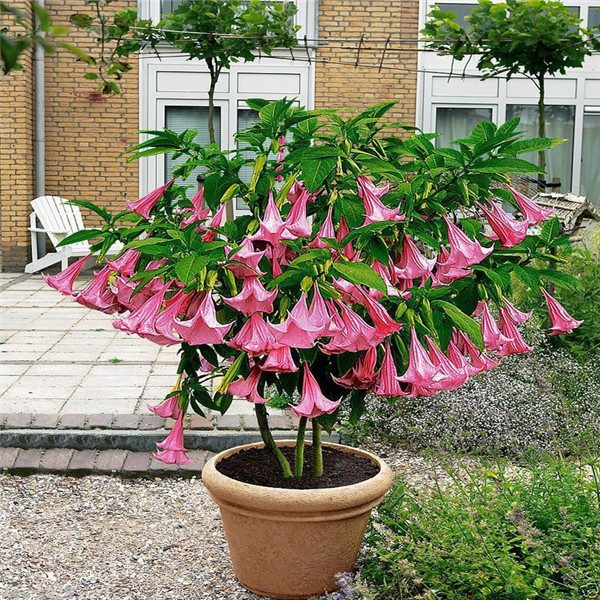

The date is often confused with Brugsmania. It is quite easy to distinguish a plant. The datura has bell-shaped inflorescences directed upwards.
A set of gramophone datura seeds (20 pieces) can be purchased at a price of 300 rubles. A grown sapling of a tree-shaped datura with a height of 30 cm is estimated at 450 rubles on average.
Datura: growing and nursing
Datura is a flower that not every summer resident decides to grow. And it's not at all about the complexity of growing. On the contrary, it is easy to grow a datura. The thing is that datura is nothing more than a plant better known as datura. And even if it does not contain poisons, like the deadly aconite, but due to the content of strong alkaloids in it, this plant has gained notoriety, and the name has become a household name.
As for the botanical classification, botanists could not decide on the date for a long time.Initially, as it should be, it belonged to the Datura (genus Datura) of the Solanaceae family, then it was renamed Brugmansia, and then, after isolating a number of plants and leaving them as Fragrant Brugmansia, it was moved back to Datura.
Despite its bad reputation, it is a very beautiful flowering plant. The flowers are large and beautiful. After flowering, a thorny fruit is formed.
Soil preparation and sowing
Datura loves fertile, but light soil, like tomatoes and eggplants. If it is not possible to purchase such soil in the store, then you can compose it yourself. To do this, in equal parts, mix ordinary soil from the summer cottage, add humus, river sand. It is desirable that the sand is not fine.
The soil, if it is collected on the street, and not purchased in a specialized store, is calcined in the oven to get rid of harmful bacteria and microorganisms that can destroy the datura even at the germination stage. If there is no oven, then all the soil can be treated with boiling water in which potassium permanganate is dissolved.
In the event that the soil from the summer cottage is too heavy, then a little chalk or crushed eggshell is added there. For looseness, you can add a little sawdust.
In order for the seeds to sprout properly, follow these simple rules:
- Since datura roots grow long, they choose a rectangular and deep box with drainage holes.
- The box is placed on a pallet and completely filled with soil.
- Water the entire soil well so that the moisture lasts for a long time.
- Seeds are evenly spread over the soil surface at a distance of 3 cm from each other.
- Top covered with dry earth no more than 1 centimeter thick.
- All this is powdered with fine wood ash, which will save the sprouts from accidental fungi.
- The box is covered with a waterproof transparent film or glass and placed on a sunny windowsill. The air temperature should be between 25 ° C and 30 ° C.
Read also: TOP 10 Best Chainsaws, Rating 2019 Reviews
Then you should be patient, as the seeds germinate very slowly. It usually takes at least three weeks to the first leaf. All this time, care must be taken so that the soil is not dry. And they moisten it very carefully, slightly opening the edge of the film or glass.
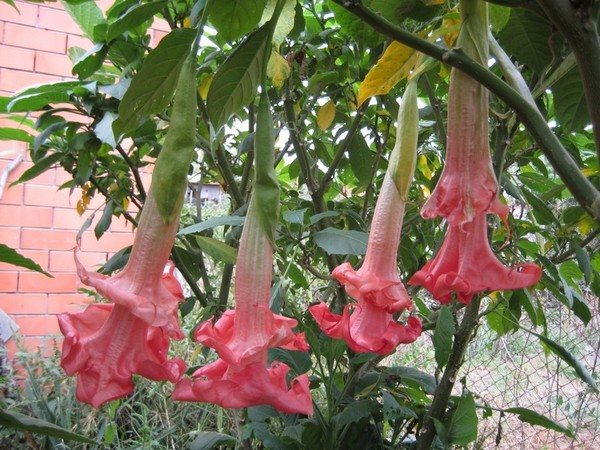

Only after the first shoots have hatched, the film is half opened, but not completely removed. After two days, the film or glass can be removed completely.
During active growth, dope needs a lot of moisture, but it is undesirable to keep the upper part of the soil moist, so that fungi do not multiply on it.
Therefore, it is watered by pouring liquid into the pan, from where the roots of the dope themselves absorb as much moisture as they need. If after six hours moisture remains in the pan, then it is drained.
The most difficult thing in this matter is watering. To understand whether there is enough moisture in the box, you need to poke your finger into the ground to a depth of 1.5 cm, if the soil is wet there, then there is enough water.
